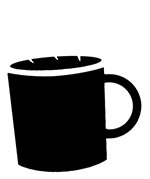Number Square Mug
Inspire someone's Maths Side with this cool Number Square Mug. Use it as an aid to: * Practice counting. * Develop a sense of number order. * Develop a sense of number place value. * Recognize Odd, Even, Prime and Square numbers. * Recognize number patterns. * Do addition, subtraction, multiplication and division. * TUTORIAL ON USING THIS MATHS AID: * EVEN NUMBERS: These are numbers that can be divided by 2 without leaving a remainder. They always end with a 0, 2, 4, 6 or 8. Eg, 8, 36, 50, and 74 are Even numbers. * ODD NUMBERS: These are numbers that leave a remainder of 1 when divided by 2. They always end in a 1, 3, 5, 7, or 9. Eg, 7, 21, 49, and 83 are Odd numbers. * PRIME NUMBERS: These are a numbers that are bigger than 1 and that can only be divided by 1 or by themselves, without leaving remainders. Eg, 8 is not Prime because it can also be divided by 2 and by 4 without leaving a remainder. But 7 is Prime because it can only be divided by 1 and by 7 (itself) without leaving a remainder. The only Even Prime number is 2. All other Prime numbers are Odd. * SQUARE NUMBERS: This is a number that is the result of multiplying a number by itself. Eg, 9 is a Square number because it is the result of 3 x 3. 25 is also a Square number because it is the result of 5 x 5. 0 is also a square number because 0 x 0 = 0. * ADDITION: Place finger on a number and then count on and read off the answer. Eg, for 9 + 11, place finger on the 9, then count on 11 squares, and see 20 is the answer. This shows visually addition’s effect of increasing a number. * SUBTRACTION: Place finger on a number and then count back and read off the answer. Eg, for 15 - 8, place finger on the 15, then count back 8 squares, and see 7 is the answer. This shows visually subtraction’s effect of decreasing a number. * TIMES TABLES: Count up in set increments (like in 2s, 3s, 5s, 10s, 12s) to lay down the basis for learning times tables. * MULTIPLICATION: Count up a number of times over a set number of squares, and read off the answer. Eg, for 3 x 4, count up 3 squares 4 times, and see 12 is the answer. * DIVISION: Place finger on a number and then count how many times you can move back to 0 over a set number of squares. Eg, for 18/3, place finger on the 18, then move back to 0 over 3 squares at a time, and realize that it took 6 counts.
$13.70

